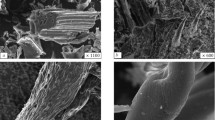Promising technology is presented for obtaining multilayer carbon nanotubes from renewable plant raw material: Sphagnum moss and Katerina SV strain maize waste. It is shown that with mechanochemical treatment of amorphous carbon, synthesized by pyrolysis from brown Sphagnum, there is formation of carbon nanotubes. The yield of nanotubes is from 19 wt.% after 7 h mechanical activation and up to 75 wt.% after 27 h. With treatment of amorphous carbon obtained from maize waste the yield of nanotubes with the same mechanical treatment duration is 11 and 42 wt.%.




Similar content being viewed by others
References
Ya. R. Krass, “Technology for producing wear-resistant magnesia refractories from the point of view of contemporary areas of development for steel smelting and other processes, ecology, resource saving, and computerization,” Ognepory Tekhn. Keram, No. 12, 11 – 12 (2002).
S. A. Suvorov, D. E. Denisov, et al., “Phase transformations of refractories during oxidation-reduction interaction of components,” Ognepory Tekhn. Keram, No. 9, 26 – 30 (19087).
L. B. Khoroshavin and V. A. Perepelitsyn, “Carbonization of refractories,” Ognepory Tekhn. Keram, No. 6, 4 – 12 (1999).
Da-Yong Chai, Ju-Long He, et al., “Behavior high oxidation temperature of carbon-carbon composite material with a modified matrix,” Carbon Techn., No. 2, 24 – 26 (2000).
V. I. Éntin, N. M. Anzhurov, G. E. Karas’, et al., RF Patent 2163900 MPK 04 35/103, 35/66, Carbon-containing refractory, OAO Semilutsk Refractory Plant, No. 20000108318/03, Claim 04.03.00, Publ. 03.10.01.
L. B. Khoroshin and V. A. Kononov, Refractory Development: Scientific Edition [in Russian], URO RAN, Ekaterinburg (1996).
V. V. Chakov, Resources of the Upper Marshes of Lower Preamur and Prospects for Their development [in Russian], DVO RAN, Khabarovsk (2009).
R. V. Kravchenko, Agrobiological Basis of Obtaining Stable Maize Grain Harvests Under Conditions of the Central Siscaucasia Steppe Zon: Monograph [in Russian], Stavropol (2010).
D. V. Onishchenko and V. P. Reva, Koks Khim, No. 5, 40 – 45 (2012).
D. V. Onishchenko, V. P. Reva, V. V. Chakov, et al., “Promising nanocomposite materials based on renewable plant resources,” Metallurg, No. 9, 59 – 62 (2012).
D. V. Onishchenko, V. P. Reva, V. G. Kuryavyi, et al., “Comprehensive processing of Sphagnum moss with the aim of preparing carbon nanotubes,” Koks Khim, No. 9, 35 – 39 (2012).
D. V. Onishchenko, V. P. Reva, V. V. Chakov, et al., “Formation of multiwalled nanotubes as a result of mechanical activation,” Dokl. Akad. Nauk, 447, No. 4, 418 – 420 (2012).
Author information
Authors and Affiliations
Additional information
Translated from Novye Ogneupory, No. 6, pp. 31 – 34, June, 2013.
Rights and permissions
About this article
Cite this article
Onishchenko, D.V., Reva, V.P. Formation of Multilayer Carbon Nanotubes from Plant Raw Material for Modification of Carbon-Containing Refractories. Refract Ind Ceram 54, 220–223 (2013). https://doi.org/10.1007/s11148-013-9578-7
Received:
Published:
Issue Date:
DOI: https://doi.org/10.1007/s11148-013-9578-7




